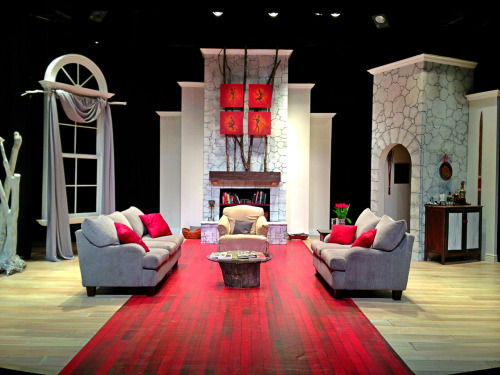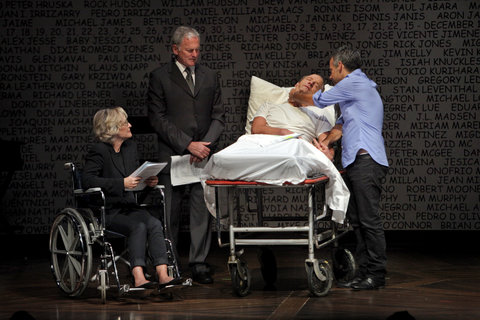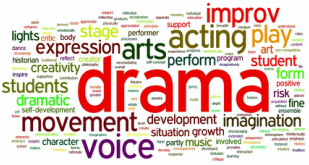Unit 14: Early Modern Theatre Movements & 20C Theatrical Diversity |
Essential Questions:
How have contemporary trends in theatre mirrored popular culture and current events? Key Terms: Realism Naturalism Stanislavski System Symbolism Unit set Theatricalism Biomechanics Constructivist Expressionism Futurism Dada Surrealism Theatre of Cruelty epic theatre alienated Existentialism Theatre of the Absurd Happenings Multimedia Environmental Theatre Poor Theatre Musical Burlesque Book Learning Activities Creative Journal: lyrics & music Classroom: lecture, articles, film clips Career Catalog: Composer or Lyricist Assessment: Weekly quiz, creative journal rubric, participation in learning activities, career catalog rubric, blog reflection |
Unit 13: Theatre from Restoration through Romanticism |
Essential Questions:
How did the Restoration and Romanticism change dramatic forms and the spaces in which they were played? Key Terms: Comedies of Manners Drame Ballad opera Sturm und Drang (storm and stress) Box set régisseur Romanticism Melodrama The Well-Made Play exposition repertory company Gesamtkunstwerk Learning Activities Creative Journal: Classroom: lecture, articles, film clips Career Catalog: Stagehand Assessment: Weekly quiz, creative journal, career catalog |
|
Unit 12: Renaissance Theatre |
Essential Questions:
What was the intended result of imposing neoclassical rules on playwrights? What was the effect of the producer-to actor-to audience relationship in Elizabethan England? How was commedia dell'arte rehearsed and performed? Key Terms: -apprentice -box -cazuela -comedia -companias de parte -corral -gallery -grove system -hireling -lazzi -masque -neoclassical ideals -patio -perspective -pit -pole and chariot -private theaters -public theaters -shareholders -sides -soliloquy -tiring house -unities -yard -zanni Learning Activities Classroom: lecture, articles, film clips Creative Journal: Write a Sonnet Career Catalog: Production Manager Assessment: Weekly quiz, creative journal, career catalog |
|
Unit 11: Designers - Costumes |
Essential Questions:
Detail the costume designer's objectives & the process by which he or she achieves them. How do those objectives serve the production? What the difference between realism & nonrealism in costume design? Key Terms: -build -costume designer -pull -realism Learning Activities Creative Journal: Design a realistic costume design and a non-realistic costume design Classroom: lecture, articles, film clips Career Catalog: Costume Designer Assessment: Weekly quiz, creative journal, career catalog |
Unit 10: Ancient Greek & Roman Theatre |
Essential Question:
What were the social and religious parameters of Greek and Roman theater? What are lasting features of Greek and Roman theatre that are still alive today? Key Terms: -agon -amphitheater -choregus -chorus -City Dionysia -dominus -new comedy -old comedy -orchestra -pantomime -parabasis -parodos -satyr play -scaena -theatron -thespian -trilogy Learning Activities Digital Classroom: lecture, articles, film clips Creative Journal: mask design Career Catalog: Stage Manager Assessment: Weekly quiz, creative journal, career catalog |
|
Unit 9: Early Asian Theatre |
Essential Questions:
What is the significance of the synthesis or integration of acting, mime, dancing, music, and text in Asian theatre? What features of Asian theatre have transposed to Western theatre? Key Terms: -bunraku -hanamichi -hashigakari -kabuki -kathakali -noh -Peking (Beijing) opera -platform stage -shadow play Learning Activities Digital Classroom: lecture, articles, film clips Creative Journal: Puppet design sketches Career Catalog: Puppeteer Assessment: Weekly quiz, creative journal, career catalog |
|
Unit 8:
|
Essential Questions:
How do designers convey their thinking in the process of bringing a show to life? Key Terms: -scale model -pitch Learning Activities: Creative Journal: Brainstorm and draft gobo designs Classroom: lecture, articles, film clips Homework: finalizing designs, build model of set design Career Catalog: Stage Manager Blog Reflection: Write a response to this unit’s essential question(s). Use moments of success and challenge from the learning activities to exemplify your understanding. Assessment: Weekly quiz, creative journal rubric, participation in learning activities, career catalog rubric, blog reflection |
|
Unit 7: Designers - Lighting & Sound |
Essential Questions:
How can the five elements of stage lighting be used to help achieve the objectives of lighting design? How is sound reproduction and sound reinforcement used in a theatre? Key Terms: -automated lights -backlighting -batten -blackout -composition -cue -dimmer -downlighting -environmental sounds -fade focus -follow spot -fresnel -gobo -light plot -motivated sounds -pan -reinforcement -reproduction -tilt Creative Journal: Brainstorm sketches, story concept, set design sketches Classroom: lecture, articles, film clips Career Catalog: Lighting Designer Blog Reflection: Write a response to this unit’s essential question(s). Use moments of success and challenge from the learning activities to exemplify your understanding. Assessment: Weekly quiz, creative journal rubric, participation in learning activities, review rubric, career catalog rubric, blog reflection |
Unit 6: Designers - Scenery |
Essential Questions:
Detail the scene designer's objectives and the process by which he or she achieves them. How do those objectives serve the production? What the difference between realism and nonrealism in scene design? Key Terms: -downstage -flat -fly loft -ground plan -left stage -props -realism -right stage -scrim -technical director -upstage -wagon Learning Activities: Creative Journal: Set design project inspiration collage Classroom: lecture, articles, film clips Theatre: warm-ups, acting exercises, Monologue Performances Career Catalog: Set Designer Blog Reflection: Write a response to this unit’s essential question(s). Use moments of success and challenge from the learning activities to exemplify your understanding. Assessment: Weekly quiz, creative journal rubric, participation in learning activities, career catalog rubric, blog reflection, monologue performance rubric |
Unit 5: The Theatre Director |
Essential Questions:
What is the process required to move a production from "page to stage"? Who is responsible for organizing and moving the process forward and what are their functions and contributions? Key Terms: -artistic director -audition -auteur director -blocking -casting -director -dramaturge -dress rehearsal -front of the house -pace -producer -run-through -spine -stage manager -stage picture -technical rehearsal Learning Activities: Creative Journal: Draft Monologue Classroom: lecture, articles, film clips Theatre: warm-ups, acting exercises Homework: director review Career Catalog: Director Homework: Draft monologue Blog Reflection: Write a response to this unit’s essential question(s). Use moments of success and challenge from the learning activities to exemplify your understanding. Assessment: Weekly quiz, creative journal rubric, participation in learning activities, review rubric, career catalog rubric, blog reflection |
Unit 4: Theatre Spaces |
Essential Questions:
Why is the relationship between the spectator and the performer important and how can that stage-to-audience relationship in the three most popular theatre architecture arrangements differ? What is a multipurpose or black box theatre arrangement? Why might such a space be desirable? Key Terms: -aesthetic distance -arena stage -corral -created of found space -fly loft -fourth-wall convention -multifocus theater -multimedia theater -orchestra -platform stage -proscenium -rake -run -thrust stage -wagon stage Learning Activities: Creative Journal: Theatre architecture sketches, monologue edits Classroom: lecture, articles, film clips, Theatre: warm-ups, acting exercises Career Catalog: Producer Blog Reflection: Write a response to this unit’s essential question(s). Use moments of success and challenge from the learning activities to exemplify your understanding. Assessment: Weekly quiz, creative journal rubric, participation in learning activities, review rubric, career catalog rubric, blog reflection |
| ||||||
Unit 3:
|
Essential Questions:
Why is it important for the actor to warm up? What does a theatrical form dictate to the actor in regard to their approach to the work? Key Terms: -burlesque -comedy -comedy of manners -farce -genre -heroic drama -melodrama -satire -slapstick -tragedy -tragicomedy -emotional recall -ensemble playing -magic if -realism Learning Activities: Creative Journal: Begin to draft a monologue. Classroom: lecture, articles, film clips Theatre: warm-ups, acting exercises Career Catalog: Actor Blog Reflection: Write a response to this unit’s essential question(s). Use moments of success and challenge from the learning activities to exemplify your understanding Assessment: Weekly quiz, creative journal rubric, participation in learning activities, review rubric, career catalog rubric, blog reflection, mime performance rubric |
Unit 2:
|
Essential Questions:
Is the playwright more or less important to the creative process than the actors and the director of a production? What are the essential elements of dramatic structure? Why are they essential to effective storytelling? Key Terms: -action -antagonist -chorus -climatic structure -climax -complication -conflict -crisis -deus ex machina -dialogue -dominant trait -episodic structure -exposition -minor characters -obstacle -plot -protagonist -representative characters -stock character -subplot Learning Activities: Classroom: warm-ups, lecture, Unit 2 notes Theatre: warm-ups, acting exercises, script reading Creative Journal: Draft a script that brings a classic folk tale to life through dialogue Career Catalog: Playwright Blog Reflection: Write a response to this unit’s essential question(s). Use moments of success and challenge from the learning activities to exemplify your understanding. Assessment: Weekly quiz, participation in learning activities, blog reflection, in-class performance of scene |
| ||||||
Unit 1:
|
Essential Question:
How do we define art in general and what is the role theatre plays as one of the arts? Key Terms: -temporal -spatial -audience -performer -theatre space -design elements -scenery -costume -lighting -sound Learning Activities: Classroom: procedures, warm ups, Unit 1 notes Theatre: theatre games Creative Journal: My App Logo, Explore the 7 Elements of Art Career Catalog: audience member Blog Reflection: Write a response to this unit’s essential question(s). Use moments of success and challenge from the learning activities to exemplify your understanding. Assessment: Weekly quiz, participation in learning activities, blog reflection |












